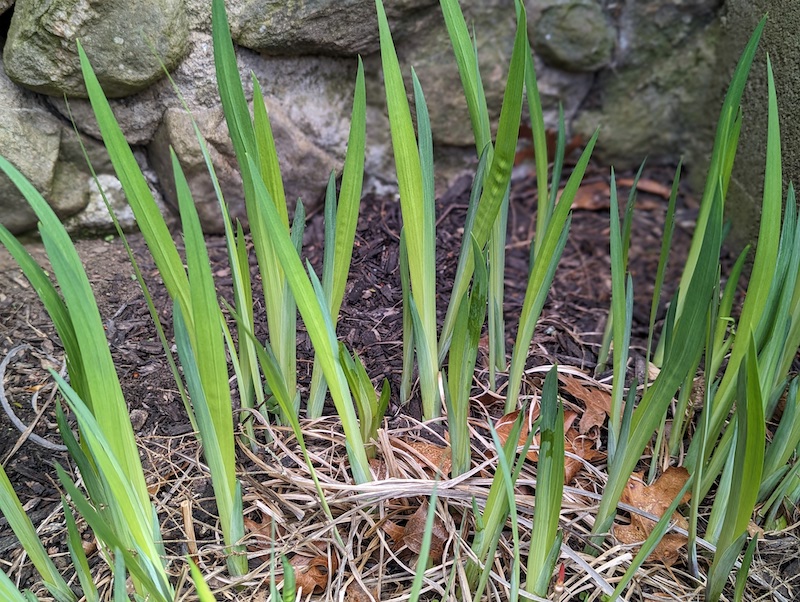Iris is a relatively low-maintenance perennial, which is extremely winter hardy. Most types and cultivars can survive winters in USDA growing zone 3 and above. The basic care techniques for the iris are similar no matter if the plant has a rhizome or bulb.

Protecting Iris in Winter
Iris is cold hardy enough to be left in the ground all winter long as long as the soil has excellent drainage and no seasonal flooding during the colder months. If you have seasonal drainage issues, the rhizome of the bearded iris can be extracted and stored after the plant loses all of its top growth in the fall.
To store the rhizome, first clean it by rinsing it under running water to remove excess soil and any pests that may be attempting to overwinter on the roots. Leave the rhizome to dry overnight in a plastic crate or on a rack so that air can circulate fully around the roots. Loosely wrap the roots in newspaper and pack them in a shallow layer. Place the box in a dark, frost-free spot over the winter. Check the rhizomes once a month for any pests or mold growing on them. When the garden soil is ready to work in the spring, the rhizomes should already be sprouting some green growth from the top!
In USDA growing zones of 3-6, iris left in the ground over winter will benefit from mulching with coarse sand, evergreen bows, or arborist chips over the growth crown and root zone. Ensure that excess mulch is removed from the crown once the plant resumes growth in the spring. A heavier mulch such as compost or shredded leaves may encourage overwintering of iris borers and is not recommended.

Cutting Back Iris For Winter
Cutting back the old top growth in late fall is an important step in preventing the most common pests and diseases of this perennial. The foliage of bearded and nonbearded irises starts to yellow toward the end of summer and is mostly dead by the first frost of fall. The foliage of bulbous types dies back early in the spring and should be left as long as possible. This is the time when the bulb stores energy for next season’s blooming.
Cut down the leaves to within 4-6 inches of the soil, and compost if there are no signs of disease or pests. As the iris goes further into dormancy, the rest of the foliage will fall off and decompose in the garden over winter.
Iris Winter Care in Pots
Irises that are left outside in containers may need to be moved out of the path of prevailing winter winds. The soil in the containers will not provide the same amount of insulation as the ground soil. Wrapping the outside of large containers with layers of burlap or horticultural fabric will add extra protection from the cold for the roots.
Watering Iris in Winter
Water iris in containers intermittently through the winter when temperatures are above 45 degrees Fahrenheit and the soil feels dry. Even though the rhizome or bulb is dormant, it will be badly damaged if left to dry completely.
Growing Iris Indoors
Dutch hybrid bulbs are lovely for bringing indoors during the long gray months of late winter. They can be easily forced in an unheated greenhouse through the winter and brought inside for display as the first shoots of leaves appear. It is not recommended to grow the bulbs completely indoors, as they need a winter chill to bloom.
Steps To Care For Iris in Winter
Caring for irises through the winter is easy and does not involve any unusual tricks or techniques. Excellent drainage through the winter is paramount to successfully growing this perennial from year to year.
Step 1 - Ensure the soil drains well. If not, the rhizomes may be dug up for storage over the winter in a frost-free, dark location such as a garage or basement.
Step 2 - Prune the top growth as it begins to yellow late in the summer or after the first frost of fall. Cut it back to within 4-6 inches of the soil.
Step 3 - Mulch the crown with 3-4 inches of shredded organic material, such as compost, leaves, or arborist chips. Make sure to remove any material from the crown when growth resumes in the spring.
Step 4 - Continue watering the plants if you garden in a zone that stays above 45 degrees Fahrenheit in the fall and winter.
 |
Author Robbin Small - Published 4-18-2023 |
